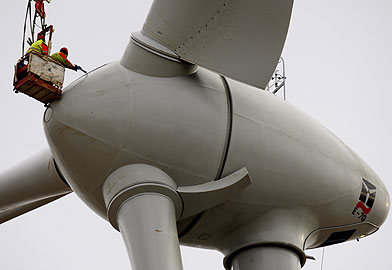A turbine spin of 80-metre blades in the North Sea wind which is ten kilometres off the southwest coast of Norway.It’s not an unusually large windmill, and its 2.3-megawatt output is unremarkable. Even its location isn’t unique.
But unlike other offshore windmills that are anchored to the sea floor, this one floats.
It is built by Siemens AG for Statoil ASA, an energy company based in Stavanger, Norway, the Hywind turbine sits on a buoyant steel cylinder extending 100 meters below the surface. Three heavy cables anchor it to the ocean floor.
Statoil wants to use this first Hywind turbine to show that windmills floating in deep water are a viable way of generating wind power while avoiding some of the regulatory and public-perception problems that come with wind farms on land.
It’s not the only company experimenting with floating platforms. An eight-megawatt floating unit has been tested off Italy, and there are plans for a deep-water wind farm off Portugal using a floating platform design called WindFloat from Principle Power Inc. of Seattle.
Hywind, however, is the only full-scale floating windmill feeding electricity into a commercial power grid today, says Sjur Bratland, asset manager for Hywind at Statoil. The unit sent its first power across an undersea cable on Sept. 21, 2009, and as of late February, it had produced a million kilowatt-hours altogether.
That’s well below the windmill’s theoretical capacity, because it has not been running full time. Statoil has been stopped and started it repeatedly to make adjustments, says Bratland. “Our goal is not to produce power but to test it [the floating windmill concept].”




